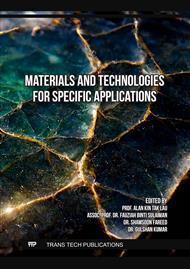[1]
Li F, Shen W, Yuan Q, Hu X, Li Z, Shi C 2022 An overview on the effect of pumping on concrete properties. Cem Concr Compos 129:
Google Scholar
[2]
Tao Y, Zhang Y, De Schutter G, Van Tittelboom K 2024 Interfacial bonding of 3D printable concrete with chemically reactive coating for automatic repair. Developments in the Built Environment 17:
DOI: 10.1016/j.dibe.2024.100333
Google Scholar
[3]
Russo N, Lollini F 2022 Effect of carbonated recycled coarse aggregates on the mechanical and durability properties of concrete. Journal of Building Engineering 51:
DOI: 10.1016/j.jobe.2022.104290
Google Scholar
[4]
Kim J, Kim N 2023 Exploring the role of thermal activation of cement exposed to the external environment on the improvement of concrete properties. Journal of Materials Research and Technology 24:2868–2878
DOI: 10.1016/j.jmrt.2023.03.195
Google Scholar
[5]
Meraz MM, Sobuz MHR, Mim NJ, Ali A, Islam MS, Safayet MA, et al 2023 Using rice husk ash to imitate the properties of silica fume in high-performance fiber-reinforced concrete (HPFRC): A comprehensive durability and life-cycle evaluation. Journal of Building Engineering 76:
DOI: 10.1016/j.jobe.2023.107219
Google Scholar
[6]
Zhu J, Kang J, Liu Z 2023 Resource recycling and carbon sequestration by carbonizing concrete washing wastewater of ready-mix concrete plant. Constr Build Mater 392:
DOI: 10.1016/j.conbuildmat.2023.131916
Google Scholar
[7]
Parsons LA, Nwaubani SO 2024 Mechanical and durability performance of concrete made using acrylonitrile butadiene styrene plastic from waste-EEE as a partial replacement of the coarse aggregate. Journal of Building Engineering 85:108635
DOI: 10.1016/j.jobe.2024.108635
Google Scholar
[8]
Mahdi S, Xie T, Venkatesan S, Gravina RJ 2023 Mechanical characterisation and small-scale life-cycle assessment of polypropylene macro-fibre blended recycled cardboard concrete. Constr Build Mater 409:
DOI: 10.1016/j.conbuildmat.2023.133902
Google Scholar
[9]
Patil S, Ramesh B, Sathish T, Saravanan A, Almujibah H, Panchal H, et al 2024 Evaluation and optimization of mechanical properties of laterized concrete containing fly ash and steel fiber using Taguchi robust design method. Alexandria Engineering Journal
DOI: 10.1016/j.aej.2023.12.009
Google Scholar
[10]
He X, Ma Q, Su Y, Zheng Z, Tan H, Peng K, et al 2022 Humid hardened concrete waste treated by multiple wet-grinding and its reuse in concrete. Constr Build Mater 350:
DOI: 10.1016/j.conbuildmat.2022.128485
Google Scholar
[11]
Jaji MB, van Zijl GPAG, Babafemi AJ 2023 Slag-modified metakaolin-based geopolymer for 3D concrete printing application: Evaluating fresh and hardened properties. Clean Eng Technol 15:
DOI: 10.1016/j.clet.2023.100665
Google Scholar
[12]
Rocha JHA, Toledo Filho RD 2024 Microstructure, hydration process, and compressive strength assessment of ternary mixtures containing Portland cement, recycled concrete powder, and metakaolin. J Clean Prod 434:
DOI: 10.1016/j.jclepro.2023.140085
Google Scholar
[13]
Momeen Ul Islam M, Li J, Roychand R, Saberian M 2023 Investigation of durability properties for structural lightweight concrete with discarded vehicle tire rubbers: A study for the complete replacement of conventional coarse aggregates. Constr Build Mater 369:
DOI: 10.1016/j.conbuildmat.2023.130634
Google Scholar
[14]
Subramanian S, Davis R, Thomas BS 2024 Full-scale static behaviour of prestressed geopolymer concrete sleepers reinforced with steel fibres. Constr Build Mater 412:
DOI: 10.1016/j.conbuildmat.2023.134693
Google Scholar
[15]
El-Hallak M, El-Hassan H, El-Dieb A, Alzamly A 2024 Synergic effect of metal-organic frameworks and process parameters on the properties of concrete subjected to accelerated carbonation. Constr Build Mater 414:
DOI: 10.1016/j.conbuildmat.2024.135016
Google Scholar
[16]
Hasan NMS, Shaurdho NMN, Basit MA, Paul SC, Sobuz MHR, Miah MJ 2023 Assessment of the rheological and mechanical properties of palmyra fruit mesocarp fibre reinforced eco-friendly concrete. Constr Build Mater 407:
DOI: 10.1016/j.conbuildmat.2023.133530
Google Scholar
[17]
Dao XH, Bui PT, Ogawa Y, Kawai K 2024 Effect of the strength grade of parent concrete on the performance of recycled aggregate treated by cement-fly ash slurry under prolonged soaking duration. Constr Build Mater 411:134528
DOI: 10.1016/j.conbuildmat.2023.134528
Google Scholar
[18]
Sayed Mohammad Akid A, Hossain S, Imtiaz Uddin Munshi M, Elahi MMA, Habibur Rahman Sobuz M, Tam VWY, et al 2023 Assessing the influence of fly ash and polypropylene fiber on fresh, mechanical and durability properties of concrete. Journal of King Saud University - Engineering Sciences 35:474–484
DOI: 10.1016/j.jksues.2021.06.005
Google Scholar
[19]
Chu Y, Guo LP, Dai GZ, Wu JD, Lyu BC, Fei XP, et al 2024 Effects of the early curing regime on the properties and pore structure of concrete in an environment with high altitudes and low atmospheric pressures. Journal of Building Engineering 82:
DOI: 10.1016/j.jobe.2023.108195
Google Scholar
[20]
Hari R, Mini KM 2023 Mechanical and durability properties of basalt-steel wool hybrid fibre reinforced pervious concrete – A Box Behnken approach. Journal of Building Engineering 70:
DOI: 10.1016/j.jobe.2023.106307
Google Scholar


